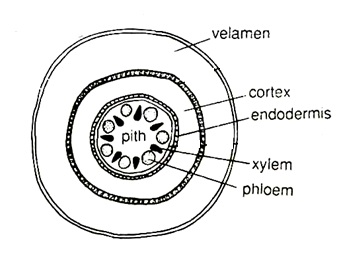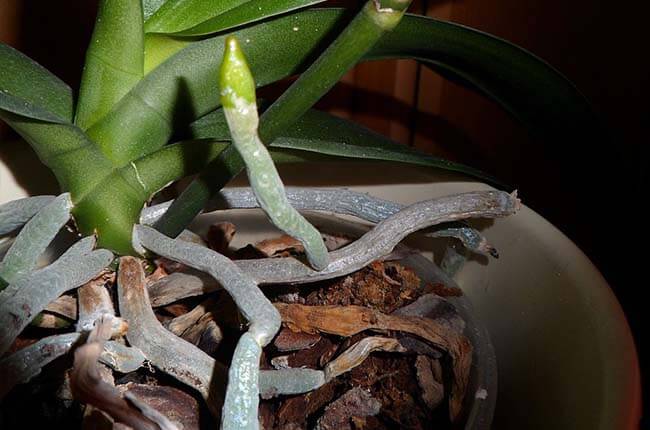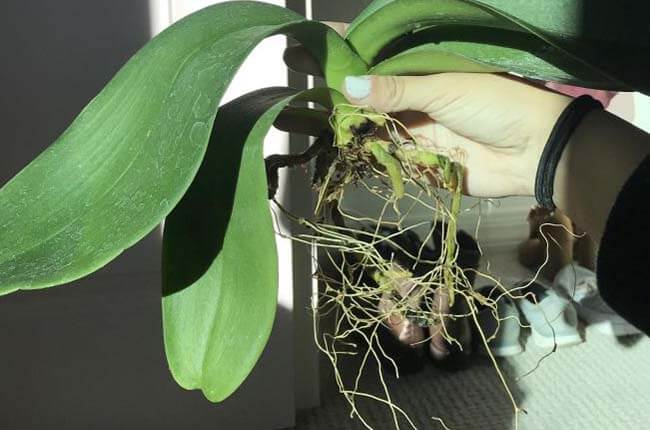If your orchids ever had rotten roots before, you must know what “stringy roots” are. Those are string-like pith or stele with a small diameter that is left behind after slipping off the brown rotten, mushy covering on the outside of a root. When you repot such an orchid, you may want to know: Should you trim or leave the stringy roots?
I recommend keeping the stringy roots, if they are not rotten. It’s because they can help stabilize the plant in its new medium. But do not expect that the stringy roots would absorb much water, if any, for the needs of the plant, because they have lost the water absorption organ called velamen.
In this article, we will explain the importance of velamen and whether stringy roots without velamen are still useful for the health of the plant.
1. How do orchid roots absorb water?
When a water droplet lands on the root of an orchid, it is sucked inside the root in the form of capillary action through the velamen cells which are on the outermost layer or covering of the root.
The water then travels via the cortex of the root before reaching the xylem and phloem.
Once the water enters the xylem and phloem of the root, it will be transported along the stem to the leaves and other parts of the plant.

2. What is velamen and its function?
Velamen (or “velamen radicum”) is one or several layer(s) of dead cells on the outside of an aerial root in an orchid. It performs many functions that are crucial and adapted for the survival of epiphytic orchids in their natural habitat. They are:
- Efficient water and nutrient uptake: Within seconds, velamen absorbs water from the atmosphere in the form of, e.g. rain, dew, mist, air droplets, like a “sponge” into the interior of the roots via capillary action. This helps epiphytic orchids to quickly absorb water and nutrients arriving in a rainfall or water dripping from overhanging branches and twigs (Hauber, Konrad & Roth-Nebelsick, 2020).
- Reduction of water loss: Apart from absorbing water, velamen slows down the evaporation of water from the cortex or inside of aerial roots. A study by Zotz & Winkler (2013) found that velamen absorbs solutions within seconds, while evaporation from the velamen takes several hours. This feature is important because aerial roots are not inside the flower pot or attached to any substratum, but hanging freely in the air.
- Retention of nutrients: Nutrients in the form of charged ions are trapped in the velamen due to positive and negative charges in the cell walls.
- Mechanical protection: Aerial roots that are hanging freely in the air have more layers of cells in the velamen than the velamen of roots that are attached to a substrate. A thick velamen helps provide mechanical protection for the interior cortex of the roots—a feature especially important for aerial roots that are hanging freely in the air.
- Protection against UVB damage: An important stress factor for epiphytic orchids is high and fluctuating sunlight, as the UVB rays can lead to degradation in plant cells. The velamen can protect the photosynthetic orchid root cortex against UVB damage (Chomicki et al., 2014).

3. Can stringy roots absorb water?
When the orchid roots rot, what becomes mushy and slips away is the cortex and the velamen. The stringy part that is left behind is the xylem and phloem.
Some orchid growers claim that the stringy roots can still absorb some water.
There is yet any scientific study to prove whether an orchid root without its velamen and cortex can still absorb water. But, after having lost velamen as the major water absorption organ, water absorption, if any, by the stringy roots would be inefficient and insignificant for the needs of the plant. Plus, the velamen also serves other functions for mechanical protection and retention of water loss.
That is why when this happens, the orchid always starts growing new roots to meet its needs, instead of repairing its stringy roots in growing back the cortex and velamen.
4. Should you trim stringy roots or leave them?
Since the stringy roots have more or less lost their water absorption capabilities, some people consider them dead and recommend trimming them to prevent them from further decomposition, which may accelerate the decomposition of the new medium.
But others recommend keeping the stringy roots only for the purpose of stabilizing the plant in the new medium.
In my opinion, if the stringy roots are clean with no signs of molding, it would be better to let the stringy roots die naturally because they can help to stabilize the plant in its new medium. Also, cutting them will increase the chance of getting an infection.
5. Will velamen grow back?
No. Once the cortex is gone, the velamen won’t grow back. In fact, the orchid will soon eliminate the stringy roots and will try to grow new roots.
6. What will happen to the stringy roots?
The stringy roots will then decompose as the plant tries to grow new healthy roots.
If all the roots are rotten and you have to remove all the roots, don’t panic. Repot the orchid in a new medium and new healthy roots will grow. Here is an article on how you can set up an intensive care unit to care for a sick rootless orchid.
Conclusion
Next time when you have a case of rotten roots, remove the brown, mushy parts. And if the stringy pith is not rotten, you can keep them to help stabilize the new plant in the new medium when you repot it. But, other than that, the stringy roots do not help much in meeting the water needs of the plant. They will soon be eliminated by the orchid in its effort to grow new healthy roots. With the right care, the sick orchid will regenerate itself.
Happy growing!
Sources
Zotz, G., Winkler, U. (2013). Aerial roots of epiphytic orchids: the velamen radicum and its role in water and nutrient uptake. Oecologia 171, 733–741. https://doi.org/10.1007/s00442-012-2575-6
Chomicki, G. et al. (2014). The velamen protects photosynthetic orchid roots against UV‐B damage, and a large dated phylogeny implies multiple gains and losses of this function during the Cenozoic. New Phytologist, vol. 205 (3), 1330-1341. https://doi.org/10.1111/nph.13106
Hauber, F., Konrad, W. & Roth-Nebelsick (2020). Aerial roots of orchids: the velamen radicum as a porous material for efficient imbibition of water. Appl. Phys. A 126, 885. https://doi.org/10.1007/s00339-020-04047-7
Plant organs. Britannica.
- Top 6 Drip Irrigation Systems for Raised Beds (2025) - January 31, 2025
- Top 10 Orchid Fertilizers: A Comprehensive Review (2025) - January 16, 2025
- Top 6 Slow-Release Fertilizers for Houseplants & Veggies (2025) - January 15, 2025

